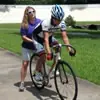Hills
Including hill training into a training plan is recommended for cyclists of all levels of ability. If you avoid races that have hills or consistently get dropped by other riders when riding hills, it's a good idea to incorporate more specific hill training into your plan.
Climbing requires a lot of strength. Include standing start intervals using big gears to help gain the strength needed for sufficient climbing.
To complete a standing start interval, practice on the road or on a stationary trainer.
- Come to a complete stop.
- Stay seated in the saddle for as long as possible. Shift your gearing to the hardest cog.
- When you start to lose your balance, stand up and sprint as hard as you can for 20 seconds.
- After the sprint is complete, sit back down on the saddle and recover for 2 to 3 minutes easy.
- Repeat 10 times.
Power
To improve your time goal for an event, it's important to increase power output. To increase your power, focus a portion of your training to work on cadence and strength. Quadriceps, hamstring and the gluteal muscles are of particular importance. Cadence drills using larger gears and slower cadences than you usually use will increase functional strength on the bike.
Practice using larger gears during training rides a few times per week. Use these gears for a few minutes at a time until you feel your muscles fatigue. Always follow with light spinning to recovery.
Riding in a Pack
It's okay to drift to the back of the pack on a group ride or race if you're tired. If you drift to the back because you aren't comfortable riding in the middle of the pack, this is a limiter to performance that you should address.
Work on soft cycling skills—the ability to anticipate what other riders are going to do directly in front of you. To practice this skill, ride with as many different groups as you can. Try to stay in the middle of the pack and don't take a turn pulling at the front. And most of all, don't let yourself drift to the rear. Stay in the middle, even if it's uncomfortable.
Let the other riders around you know what you're doing. Chances are they'll give you some pointers if they see you struggling. With time, you'll become less tense and more comfortable riding around others.
Lack of Endurance
If you notice that you quickly become out of breath during a race and especially fatigued during longer climbs, you may lack the necessary aerobic capacity for the event you've chosen.
A good way to monitor your level of endurance is with a heart rate monitor. If you become out of breath when your heart rate hits 175, then interval training in this heart rate zone is likely what you need.
- Ride for 30 seconds once your heart rate reaches 175 bpm (beats per minute). Recover for one minute.
- Repeat five times (one set).
- Work up until you can complete two sets.
- Once you're able to complete two sets, move up the duration of the interval from 30 seconds to one minute.
Time in the Saddle
Fatigue before the completion of an event is a key indicator that you haven't done enough base mileage during the offseason. If your goal is to complete a 62-mile event and you fatigue at the 40-mile mark, make increasing your base mileage before your goal event a priority.
Count backwards from the event so that you can increase your long ride by 5 miles each week (or 10 percent if your goal is longer) until you reach 62. If you're going for a specific time, you may want to ride even further than the distance of the event.
Related Articles:
 Ready to ride? Search for a cycling event
Ready to ride? Search for a cycling event



